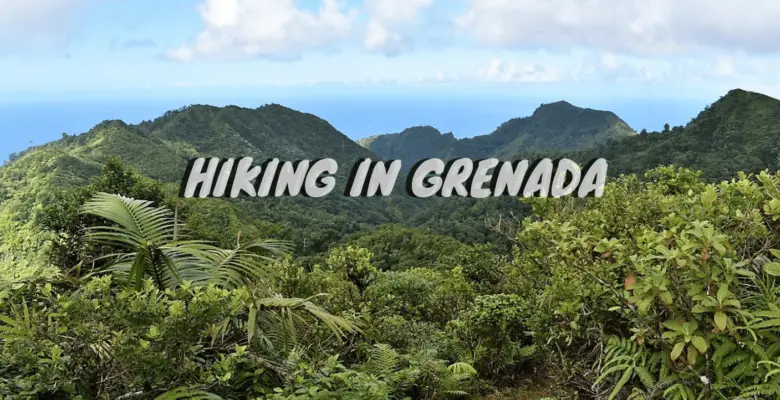
Hiking in Grenada
Hiking in Grenada is a wonderfully rewarding experience with a variety of stunning trails ranging from rainforest shrouded peaks, crystal clear waterfalls, to coastal hikes along pristine sandy beaches and picture perfect turquoise waters
Helping You to Plan a Grenada Hiking Adventure
For many people, particularly when they’re first getting into hiking, the concept of a hiking holiday is one of the most exciting goals to work towards. The idea of getting away from it all and exploring an exciting and undiscovered (at least by you) new landscape is tantalising indeed – but it’s also probably fair to say that when we say ‘hiking holiday’, most people usually envisage a fairly prescribed getaway.
Forests, moorlands, hills and mountains – usually fairly close by to where we live (or at least usually within driving distance, in the same country) tend to be the go-to options.
There’s certainly nothing wrong with this of course, but what about more far-flung, exotic destinations? Hiking can be enjoyed anywhere in the world, so today we’re taking a look at something a little more exotic – hiking in Grenada.
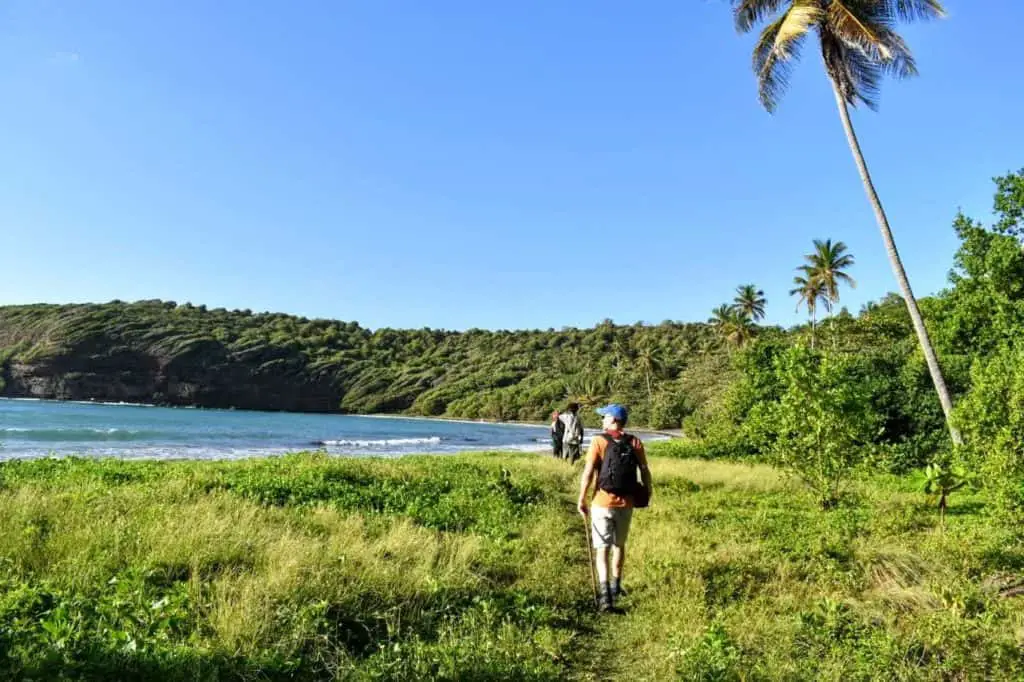
Grenada holds a place close to my heart as I was lucky enough to live on the Spice Isle with my family for two years, from 1979-1981.
This guide will cover all (or at least the vast majority) of the things you’ll need to think about when hiking in Grenada, including the preparations you’ll need to make, the equipment you’ll need to bring, and some tips on the kinds of places and scenery you should think about visiting. Without further ado, here is our complete guide to the perfect Grenada hiking experience…
Grenada – a brief summary
Before we begin, a little about Grenada itself. Situated Northwest of Trinidad and Tobago, and Southwest of Saint Vincent and the Grenadines, Grenada is a country in the West Indies that could be the perfect example of the culture and landscapes of the tropics.
The country itself consists of 7 islands in total, including the island of Grenada itself, and six smaller islands North of this; the largest of these is Carriacou and Petite Martinique. Grenada is also known as the ‘Island of Spice’ (particularly relevant to this blog, as I’m sure is apparent!) due to its significant export of nutmeg and mace, and despite its relatively small size (a mere 134 square miles).
Grenada has a complex history of territorial rule – for close to one hundred years in the 17th Century, Grenada was colonised by the French, but control was ceded to the British following the Treaty of Paris in 1763.
Despite a few brief periods of political upheaval, Grenada remained a British territory until 1974, when it achieved full independence. Since then Grenada’s political state has been fairly tumultuous, but have remained somewhat more stable since the withdrawal of American troops at the end of 1983.
There are naturally far more things we could say about Grenada’s culture and history, but uncovering these things for yourself is one of the most exciting things about adventuring into a new country, so we’ll leave it at that. When it comes to hiking in Grenada, however, a couple of things that are relevant include:
Climate in Grenada
Grenada is classified as a ‘hot tropic’ country, meaning it remains hot and humid pretty much all year round, which is great for escaping the bite of winter. There is a period of slightly drier, cool weather from January to around April (although temperatures still range between 22 and 31 degrees Celsius – hardly chilly!). Throughout the rest of the year, the temperatures don’t increase too dramatically, but there is an intense humid and rainy season between June and December.
Despite the consistent temperatures, the rainy season results in humidity that can make Grenada, as with all tropic destinations, feel a lot more sultry, which in turn can make the idea of hiking less appealing – particularly if you’re not used to it! For your first visit, it’s probably best to visit in the early months.
The rains in Grenada follow a typical tropic pattern, in that they usually consist of sudden intense downpours or storms, but rarely last long. There are between 7 and 8 hours of sunshine per day on average, throughout the entire year.
Due to its location in the tropics, concerns about hurricanes and other severe incidences of weather are understandable, but fortunately, Grenada is located in the very southernmost part of the Hurricane belt, meaning it is very rarely affected by the serious storms which can cause a catastrophe in this part of the world. In fact, in the past 50 years, it has only experienced the impact of three hurricanes.
Tips For Hiking In The Tropics
So now you have a bit of an understanding about Grenada as a place, let’s get down to business. Hiking in Grenada is naturally a very different experience to hiking in somewhere like the UK, and there are a few things you’ll need to be aware of before embarking on your first adventure there.
Hiking in the tropics can seem like a fairly daunting prospect the first time you give it a try, but the good thing to know is it really isn’t as challenging or gruelling as you might expect. It’s a wonderful experience and provided you prepare adequately and make sure you get yourself in good shape for hiking, you’re sure to have the time of your life.
Before setting off on your trip, it’s important to do plenty of research so you know what to expect (the fact you’re reading this article is a great start!) – it’s a good idea to make a checklist of all the things you’ll need to bring, and any preparations you’ll need to make. So:
Equipment for hiking in Grenada
A hiker’s equipment or kit list is one of his or her most valuable tools. You wouldn’t attempt to go skiing without the right gear, and hiking is no different. Particularly when it comes to hiking in Grenada and other tropical destinations, carrying the right things to ensure your hike is manageable, safe and enjoyable is absolutely vital.
Fortunately, while the comparatively more extreme climate and conditions might make it seem like you’ll need to invest in an abundance of specialist equipment, this isn’t necessarily the case. In fact, many of the things you’ll need to enjoy your Grenada hiking adventure will already be in your possession, and many others will simply be common sense.
First, we’ll go over the things that every hiker needs on every hike. These are commonplace, and you’ll almost certainly already own plenty of them. The basic checklist includes:
- Hiking boots – good quality
- Water bottle or supply
- Hiking trousers
- A sturdy backpack (not too big or heavy, but that will adequately carry your supplies
- Map
- Compass
- GPS
- A loud whistle
- Emergency equipment – torch, first aid, emergency shelter etc
Maps and compasses might not be necessary if you’re hiring a guide (we’ll get onto that later!), but for the most part, this is a fairly standard kit list. For more tips on the basics you’ll need to get together, take a look at our 28 hiking tips for beginners.
When it comes to hiking in the tropics, it’s worth noting that you might need to be a little bit more thoughtful when planning exactly what type of items to bring. In particular, consider:
- Lightweight clothing
The high humidity of Grenada means that you’ll work up a sweat, and fast. You’ll want to bring lightweight, breathable trousers and tops, and you almost certainly won’t need jumpers or other kinds of warm clothing. The same applies to your boots, which you’ll want to be sturdy but breathable and light too.
- To waterproof or not to waterproof?
The tumultuous and temperamental nature of the weather in Grenada means waterproofing can be a tricky question. If you’re caught in a typical tropical storm, even a short one, traditional waterproofs aren’t really going to do you much good. They also can add an additional layer of clothing that you may not want on a hot day, but this one is a personal choice! If you do opt for waterproofing, make sure it’s thin and lightweight.
- Plentiful water
You’re going to sweat, a lot, when hiking in Grenada. Sorry to be graphic, but this is simply unavoidable. As a result, it’s absolutely vital to bring an abundant supply of water with you, even for a short hike. Small water bottles probably won’t cut it, so it’s best to opt for something like a Camelbak or similar back-mounted water supply system – or at the very least a large bottle with good capacity.
- Suncream
In the tropics, the sun is strong, hot, and consistent. You’ll need plenty of suncream, and it’ll need to be a high factor. Standard advice applies, and you should do your best to avoid direct sun during the middle of the day (this is the ideal time for a relaxing, shaded lunch break instead).
- Sunhat and Sunglasses
More sun-related gear, but equally vital. You’ll want to shelter the top of your head from the harsh rays, and sunglasses will be a must so you can keep your vision clear and unobscured.
- Insect repellant/bite cream
As with countless tropical and humid destinations, Grenada is home to an army of mosquitos and other biting insects, so you’ll need to ensure you pack plenty of insect repellant. Make sure it’s in a form that makes it easy to apply throughout the day as and when you need it. It’s also a very good idea to carry some bite cream too, just in case!
Preparations
When it comes to preparing for your trip, you’ll need to think about quite a few things. Unless you live in Grenada, then this will effectively be a hiking holiday, and as such, you’ll need to plan everything from flights to accommodation, as well as any guided trips you want to enjoy etc.
How you approach this will usually depend on whether or not you’re planning a specific hiking holiday, or whether you’re planning a holiday and are considering enjoying a hike while you’re there.
If you’re opting for an exclusively hiking-focussed trip, then it’s a good idea to research the walks and locations you want to visit before planning or booking anything. With these in mind, you can choose a suitable length of stay, pick accommodation close to these (if appropriate), and plan out your itinerary.
On the other hand, if you’re planning a holiday to Grenada and you think you might enjoy a hike during your stay, you can swap this around. Plan all of the other admin for your trip, and then do some research about where you’re staying, where will be accessible, and set aside a day for your walk.
It’s also worth talking a bit about fitness. We linked to our article on this earlier, and while there isn’t too much to say about this, essentially you should just bear in mind your overall capabilities for hiking.
There are plenty of hikes for all abilities on Grenada, so you won’t be excluded, but the slightly more challenging conditions in terms of climate mean that you should potentially scale back the expectations of your physical ability slightly – or at least acknowledge that Grenada can pose a slightly more challenging terrain than your local area might.
Safety
When it comes to hiking in the tropics, there are a few things you’ll need to think about in terms of safety. With adequate consideration and preparation, however, there isn’t anything you’ll need to panic about.
- Take your time
When setting out on your first hike, and particularly as you get underway, your body will experience something it’s probably not that used to – exercise in a very hot, very humid climate. It’s really important to take things easy when you start out and don’t feel tempted to push yourself too hard.
Acclimatise, drink plenty of water, even if you don’t feel thirsty. You may find you lose your appetite, or get headaches, and this can be a bit disorientating and even a bit frightening, but eat regular healthy snacks for energy, and don’t stop drinking!
- Watch out for dangerous animals! (Or not)
Many travellers might assume that, as a tropical destination, Grenada may be replete with poisonous snakes, lizards, and insects just waiting to launch a deadly attack at any unsuspecting hikers. Fortunately, this isn’t actually the case.
Sure, there is some unusual native fauna (take a look at our Instagram account and see the Iguana we snapped when we were in Grenada’s neighbouring island, Carriacou!) but there aren’t any lethal toxic bites you’ll need to worry about.
With that said, it’s always important to be mindful when walking anywhere in the wild, and the exotic nature of the wildlife you may encounter in Grenada can make it tempting to throw caution to the wind in pursuit of a memorable one-to-one moment or photograph.
Remember that these aren’t zoo animals, they’re wild, and should never be disturbed or approached too closely. If you’d like to take a picture, keep your distance, turn the flash off and use that zoom!
Where to hike in Grenada
Now we get on to the fun part. With the above considerations in place, you should be adequately prepared for your trip in terms of equipment and planning, and once you have your accommodation and flights booked (or possibly even before), you can get down to the business of deciding where you want to hike.
Grenada is a beautiful, idyllic island with a rich and diverse landscape. Turquoise oceans (which are warm enough to swim in year-round), lush verdant canopies, mountains offering views that are simply incomparable – the list goes on, and few places are quite as rewarding to hike. With that in mind, here are a few of the different highlights the island has to offer, and a few examples of routes you can take to enjoy them:
Grenada’s dramatic topography makes home to a bountiful supply of waterfalls, which are tranquil, cooling, and offer the perfect destinations/marker for a hike. The waterfalls, often set among Grenada’s mountainous regions, are popular among visitors, and there are plenty to visit. There are also mountains, nature reserves, and other beautiful attractions that hikers should consider – a few standouts include:
-
Royal Mount Carmel Waterfalls
If you would like just a short hike leading you to a couple of contrasting but equally picturesque falls, Royal Mount Carmel Waterfalls could be just what you are looking for. Situated 3 miles (5 km) south of Grenville, Grenada’s second biggest town, the falls’ entrance is literally just off the main East Coast main road, making them extremely accessible. Don’t forget to take your swimming gear as you will definitely want to take a dip in the beautiful crystal clear waters of these falls.
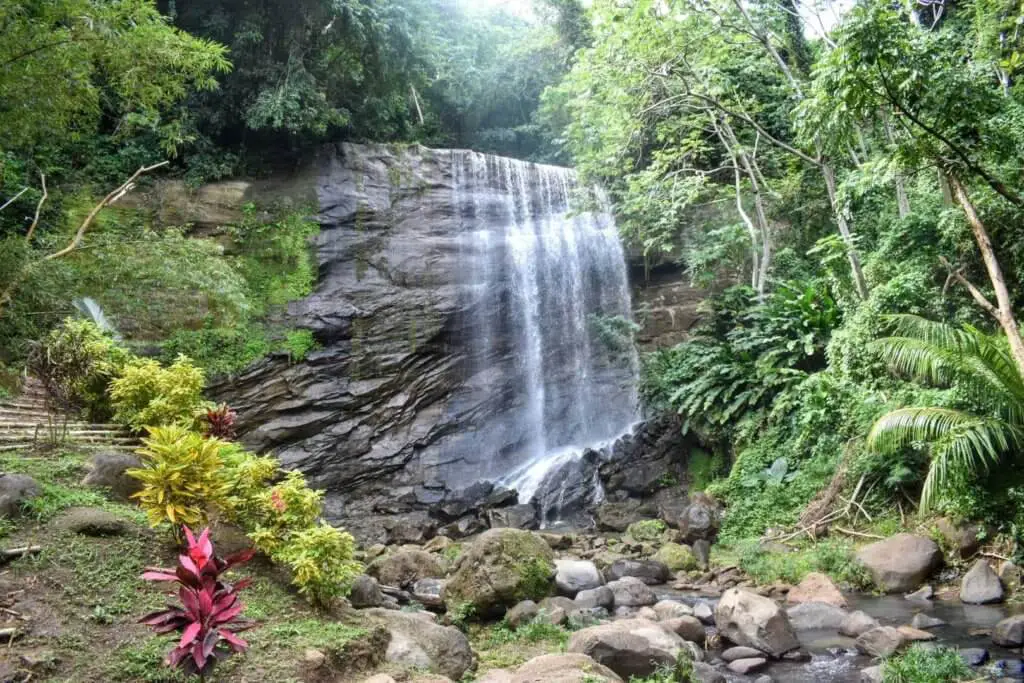
-
The Seven Sisters Waterfall
The Seven Sisters waterfall is one of the most popular sights to take in in the Grand Etang National Park (which lies in the south-central part of the island and is a must-see destination). The Park is something of a Mecca for hikers on Grenada, and the Seven Sisters Waterfall trail leads to a collection of several pools – the highest of which is most popular as a swimming pool. Make sure you’re prepared to get muddy/wet on this hike!
-
Concord Falls
Another popular and somewhat deceptively simple hike is the trail at Concord Falls. The falls are made up of three waterfalls, and while the first is easy to reach, the second, and in particular the third is considerably more challenging to reach. This is a hugely rewarding hike, that is best approached with the help of a local expert guide.
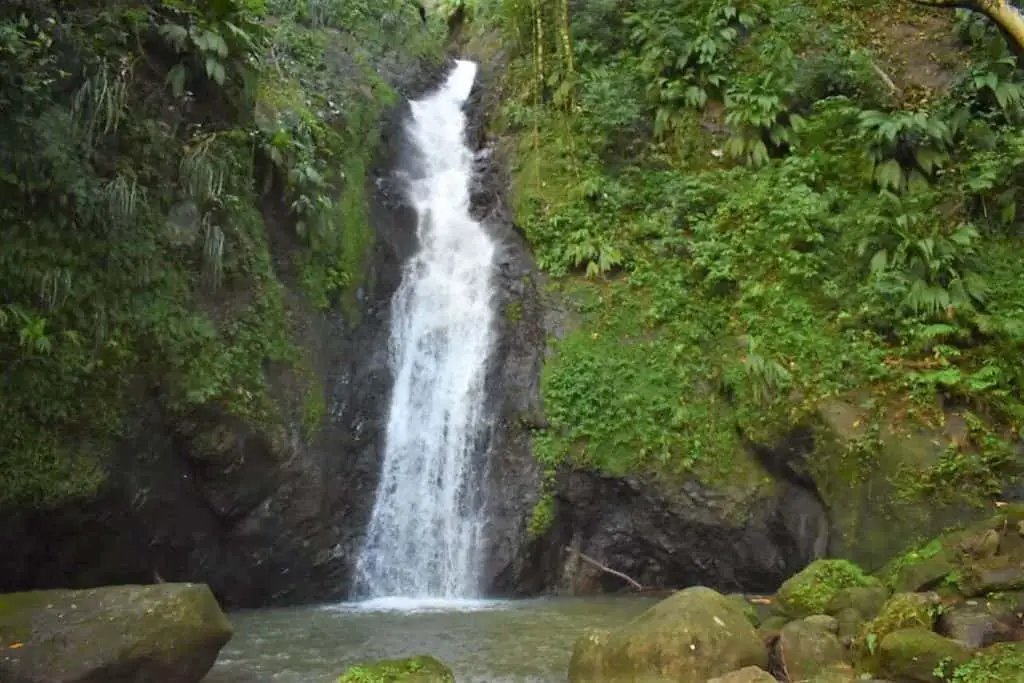
-
Mount Qua Qua Hike in Grand Etang National Park
This is a well-known trail on the island, that isn’t too difficult to find – but will provide a moderate challenge to hikers. Grand Etang Lake itself is the crater from a long extinct volcano and is a picturesque place to start the trail.
The Mount Qua Qua hike itself follows a fairly obvious route that is well-trodden, steep in places and where the use of a walking pole will certainly help!
Keen hikers can continue and ascend to the peak of Mount Qua Qua, which offers breathtaking views of both Grand Etang Lake as well as Grenada’s East and West coast.
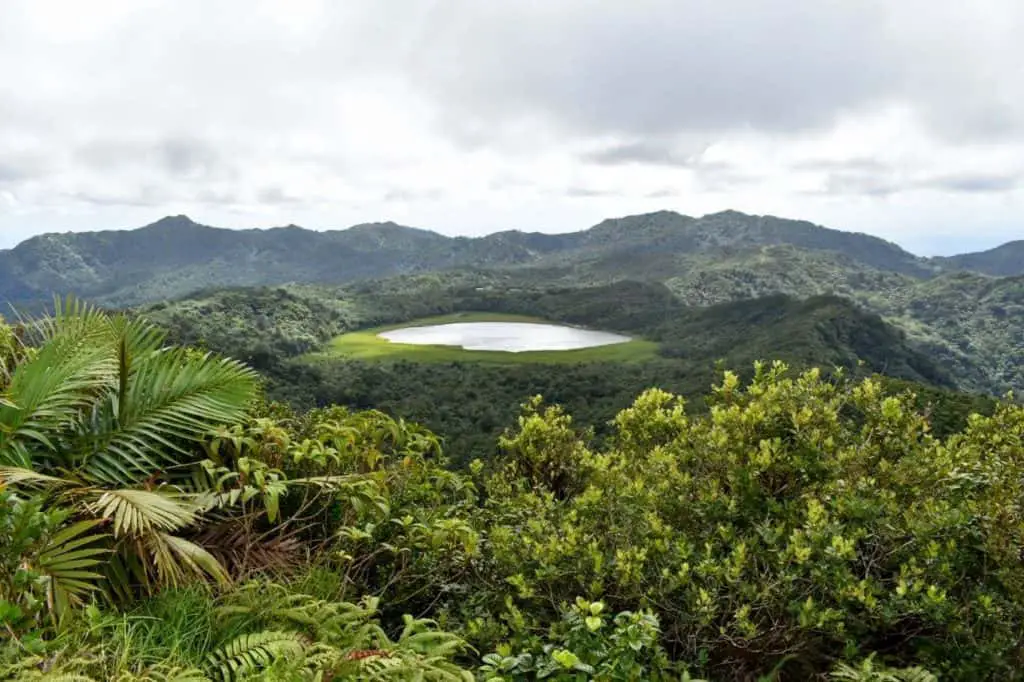
-
Welcome Stone
If you plan on heading to the peaceful northeast of Grenada, a visit to Welcome Stone is a must. Here you will get to experience some spectacular views across the beaches of Bathway and Levera as well as the myriad of small islands that sit off the northeast coast.
It is possible to drive to Welcome Stone but the 6 mile (10km) return hike from Bathway is a far better option. This way you get to experience some true Grenadian countryside prior to arriving at the perfect vantage point, atop Levera Hill.

Hiking in Carriacou
If you are visiting Grenada it is well worth your while taking the short flight or boat ride to the neighbouring island of Carriacou and spending a few days. This is a true paradise island offering pristine sandy beaches and a number of super hiking opportunities:
High North Peak – Highest point on Carriacou

Gun Point – Most northerly point on Carriacou
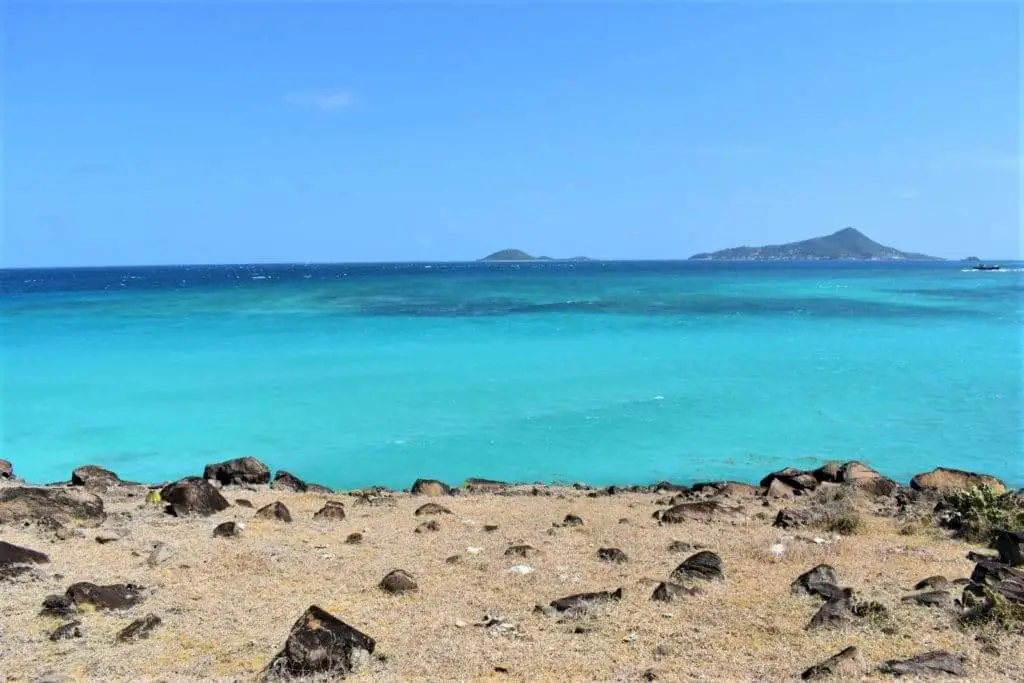
Anse La Roche Beach – Secluded paradise (best beach on the island!)
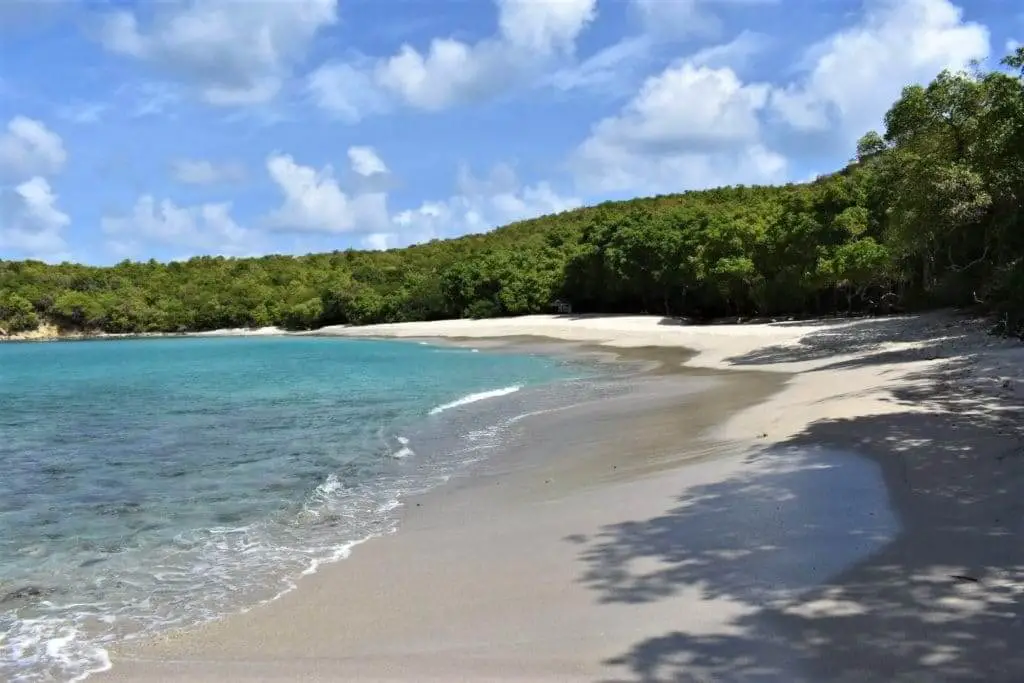
Going Solo vs. Hiring a Guide?
This is something that all hikers will need to consider when hiking in Grenada. The island’s main source of revenue comes from tourism, and there are countless expert guides who have provided hikes and tours their entire lives. They know the island and its trails like the back of their hand, and they are almost always incredibly helpful, friendly, and accommodating.
With that said, some hikers might find the idea of using a guide slightly counterintuitive – planning your own route, setting out with map and compass and discovering the beauty of the island on your own merit can be more appealing to some, with the notion of using a guide almost like a ‘cop out’.
In our opinion, we think it very much depends on the individual hiker in question, and their own experience, but we can heartily recommend the services of a local guide, particularly for the first hike, or if you’re planning any longer or more dangerous routes. This is because employing a local guide offers a few unique benefits:
- It takes the stress off planning
While planning a route might be part of the fun for many travellers, hiking in Grenada can be tricky if you don’t know the area, and even potentially dangerous. This can make the route-planning process stressful, but a guide will already know the routes, and using one means you can simply enjoy the walk. It certainly doesn’t make the trail any easier!
- A local guide can provide local knowledge
As you hike across the island, you’ll likely come across all kinds of sights and important destinations – but even the best guidebook in the world won’t be able to offer you the same level of insight as a local guide.
They’ll be able to tell you about the history, cultural significance, and even myths and legends about the locations you visit (many of which, particularly the waterfalls, are of significant spiritual importance).
- Guides can educate you on the flora and fauna
One of the best things about hiking in Grenada and the tropics, in general, is all of the incredible flora and fauna you’ll be exposed to during a walk. From towering plants to unusual and fascinating insects and animals, there are countless wonders of the natural world to be enjoyed on the island, and a guide will be able to tell you all about them – something that can be extremely tricky to discover in a guidebook (or even with the ‘infinite’ wisdom of a digital assistant – saying ‘He Siri what’s that plant’ doesn’t tend to get you very far!
Useful resources for hiking in Grenada
During our research for our own trip to Grenada, we discovered a few helpful resources, so we thought we’d share them here:
-
A collection of the best hiking trails in Grenada from Wikiloc
-
Some more trails from Pure Grenada
-
Some gear tips for tropic hiking from the Telegraph
-
A selection of accommodation from Just Grenada (although you can also use Airbnb!)
-
A handy tropic holiday checklist
Hiking in Grenada – Conclusion
Grenada is such a stunning location, and arguably one of the most rewarding, memorable and enjoyable for those who enjoy the great outdoors. If you’re preparing for some hiking in Grenada, you should know that while preparation and planning are certainly important, you’re in for a real treat – and an adventure you’ll never forget.
Check out our blog/social media posts covering the hiking experiences that we enjoyed on both Grenada and neighbouring Carriacou. Our five-week adventure from December 2018 – January 2019 was simply magical and we can not recommend these islands highly enough as a hiking destination!
Like Our Article? Please Pin it!
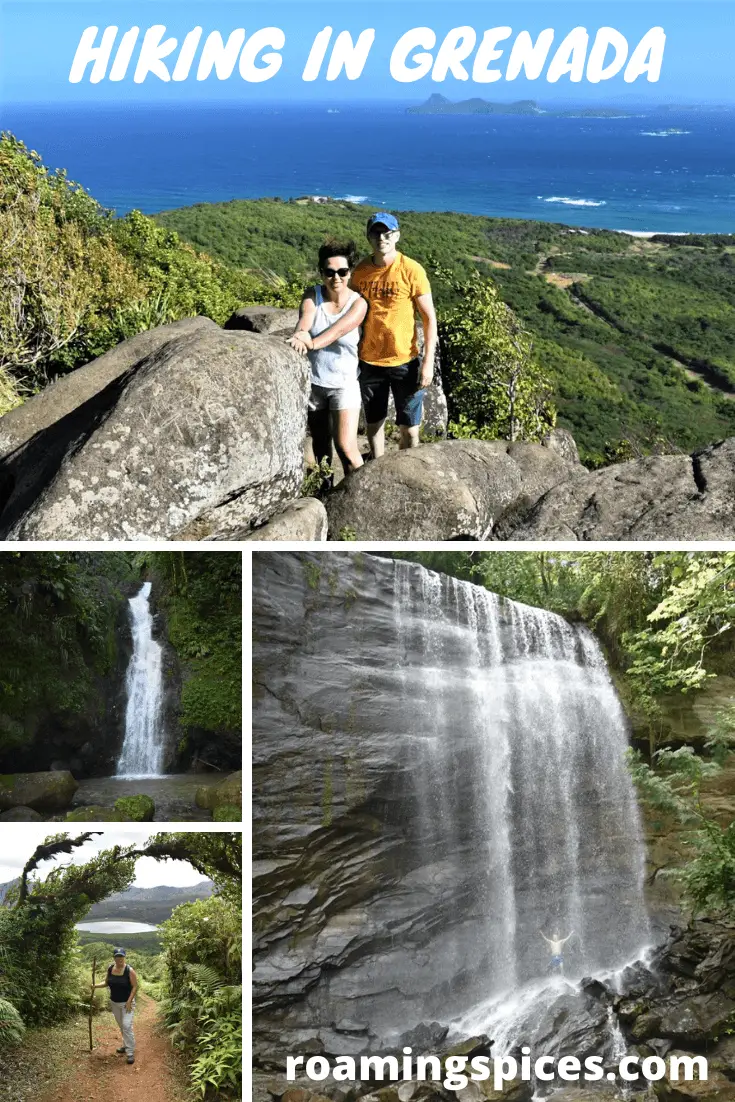

Gavin,
My wife and I lived in Grenada from 1979-’82. We were volunteers with Mennonite Central Committee. I taught school at St Johns Secondary. We lived in Gouyave. Our middle son was born at the Gouyave Clinic. I’m surprised our paths never crossed. We returned to Grenada for the first time in 2019 right before covid for a 2 week vacation. Now we are going back again-last 2 weeks in April. We will be with our oldest daughter(who was 2 weeks old when we first arrived) and her spouse and 2 cildren. Also with us will be our youngest plus his spouse and 2 children. We will be staying on the NW side at AirBNB and love the water and beach. However we are also looking forward to some interior hiking which seems like it may be more accessible now then it was 40+ years ago. Thanks so much for your informative blog.(have you ever read “Swimming in the Volcano” by Robert Shacoccis)?
Hi Todd, thanks for the nice website comment with all this detail. It is always great to hear from those who shared this wonderful little island with us for a period of time. We spent the first 6 months in Lance Aux Epines and 18 months in Bathway. My Dad (John Evans) was the Managing Director and pilot with Inter-island Air Services (IAS) based out of Pearls Airport near Grenville. My sister and I were schooled at Miss Redhead’s School in Sauteurs. How lovely that you are getting to go back to Grenada once more, especially with all your family! I really hope you get to enjoy some nice hikes too. My wife and I certainly enjoyed a few when we visited in 2018. I have never read Swimming in the Volcano by Robert Shacoccis but having read the summary on Amazon, it certainly looks intriguing! Have a super trip and send our love to the Spice Isle.